Abstract
Eight rapid Poly R-478 dye-decolorizing isolates from The Netherlands were screened in this study for the biodegradation of polycyclic aromatic hydrocarbons (PAH) supplied at 10 mg liter(-1). Several well-known ligninolytic culture collection strains, Phanerochaete chrysosporium BKM-F-1767, Trametes versicolor Paprican 52, and Bjerkandera adusta CBS 595.78 were tested in parallel. All of the strains significantly removed anthracene, and nine of the strains significantly removed benzo(a)pyrene beyond the limited losses observed in sterile liquid and HgCl2-poisoned fungus controls. One of the new isolates, Bjerkandera sp. strain Bos 55, was the best degrader of both anthracene and benzo(a)pyrene, removing 99.2 and 83.1% of these compounds after 28 days, respectively. Half of the strains, exemplified by strains of the genera Bjerkandera and Phanerochaete, converted anthracene to anthraquinone, which was found to be a dead-end metabolite, in high yields. The extracellular fluids of selected strains were shown to be implicated in this conversion. In contrast, four Trametes strains removed anthracene without significant accumulation of the quinone. The ability of Trametes strains to degrade anthraquinone was confirmed in this study. None of the strains accumulated PAH quinones during benzo(a)pyrene degradation. Biodegradation of PAH by the various strains was highly correlated to the rate by which they decolorized Poly R-478 dye, demonstrating that ligninolytic indicators are useful in screening for promising PAH-degrading white rot fungal strains.
Full text
PDF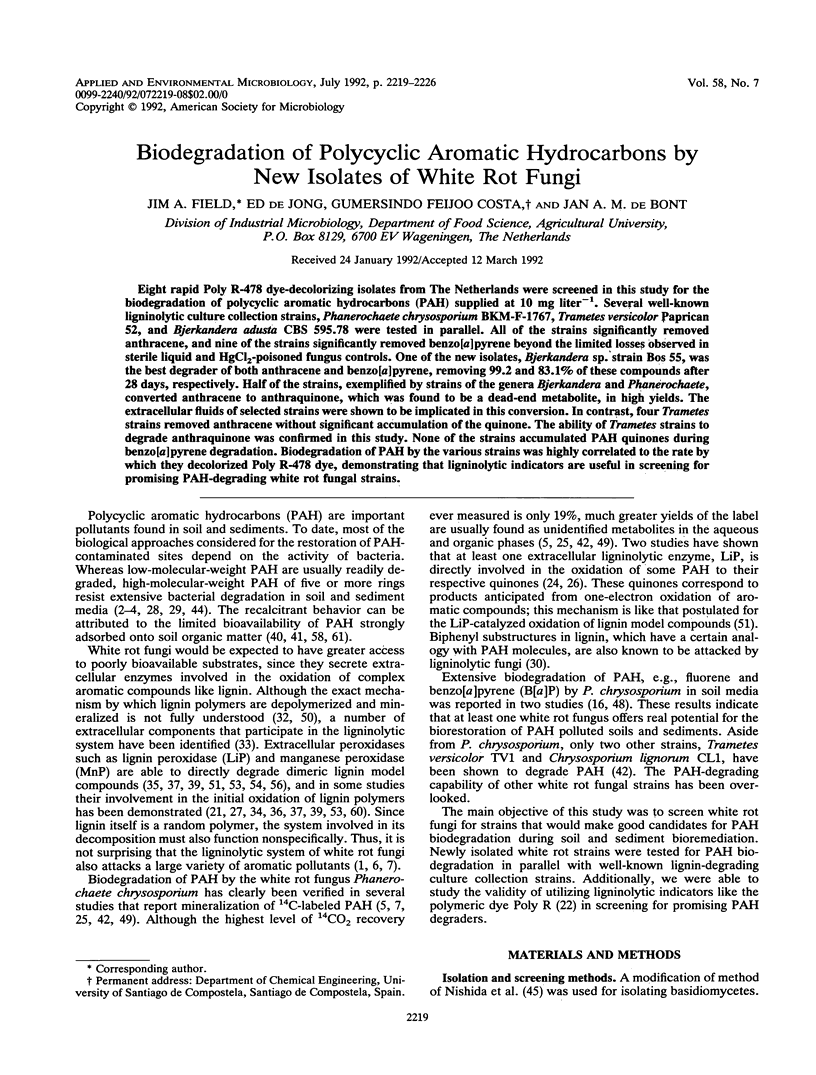
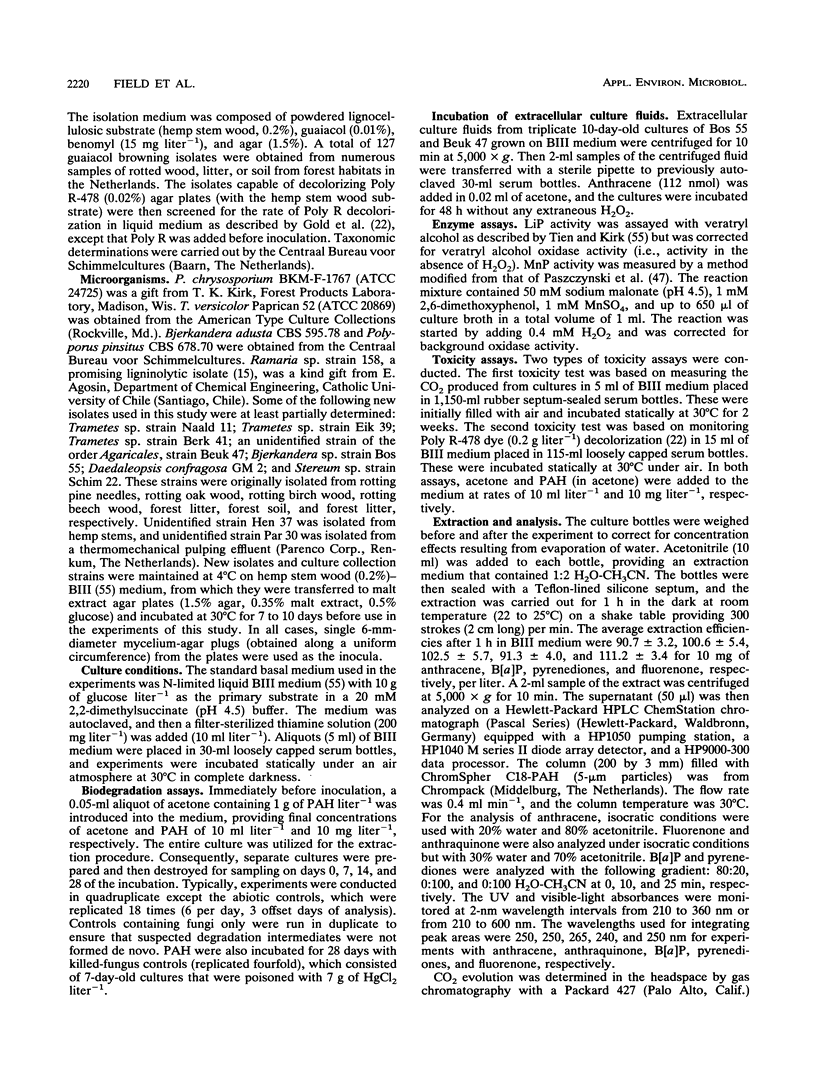
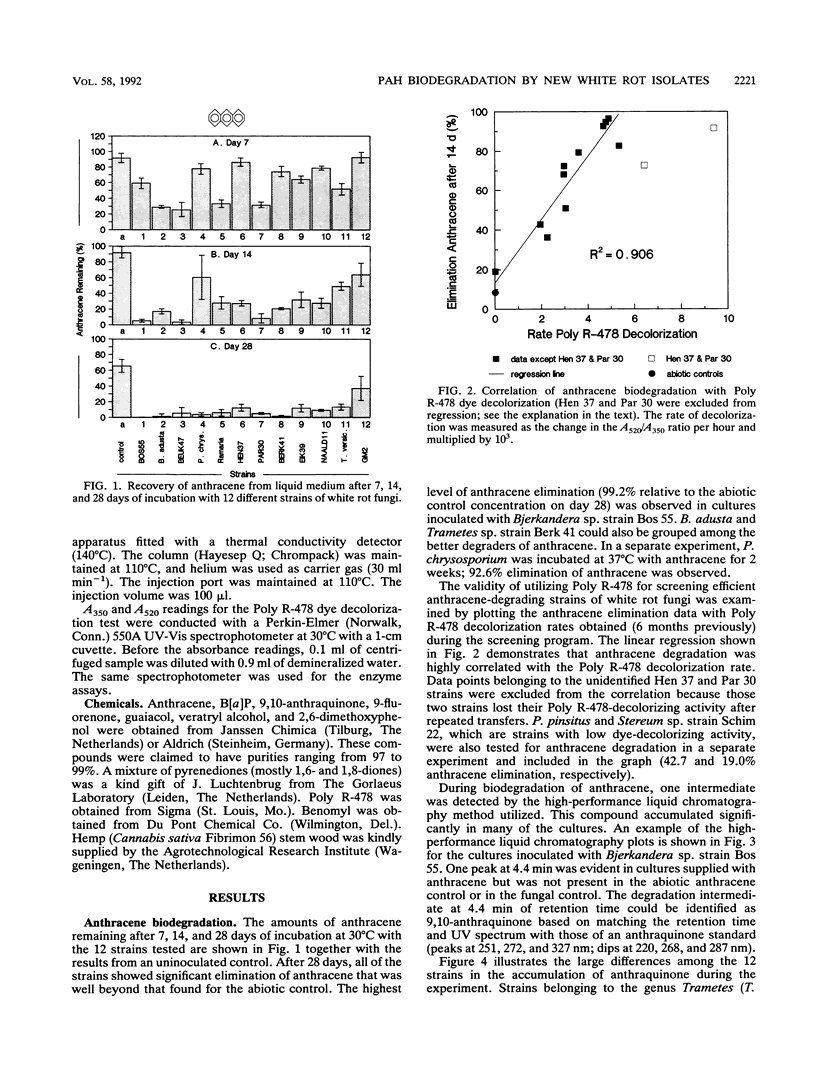
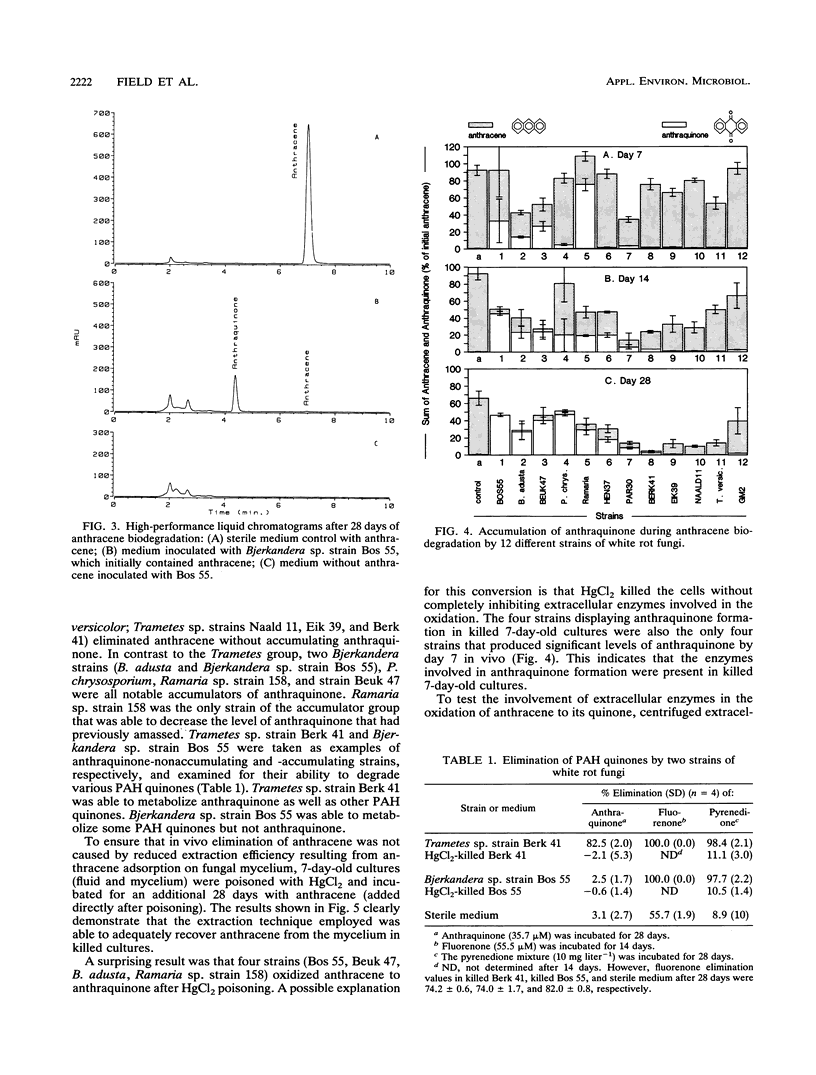
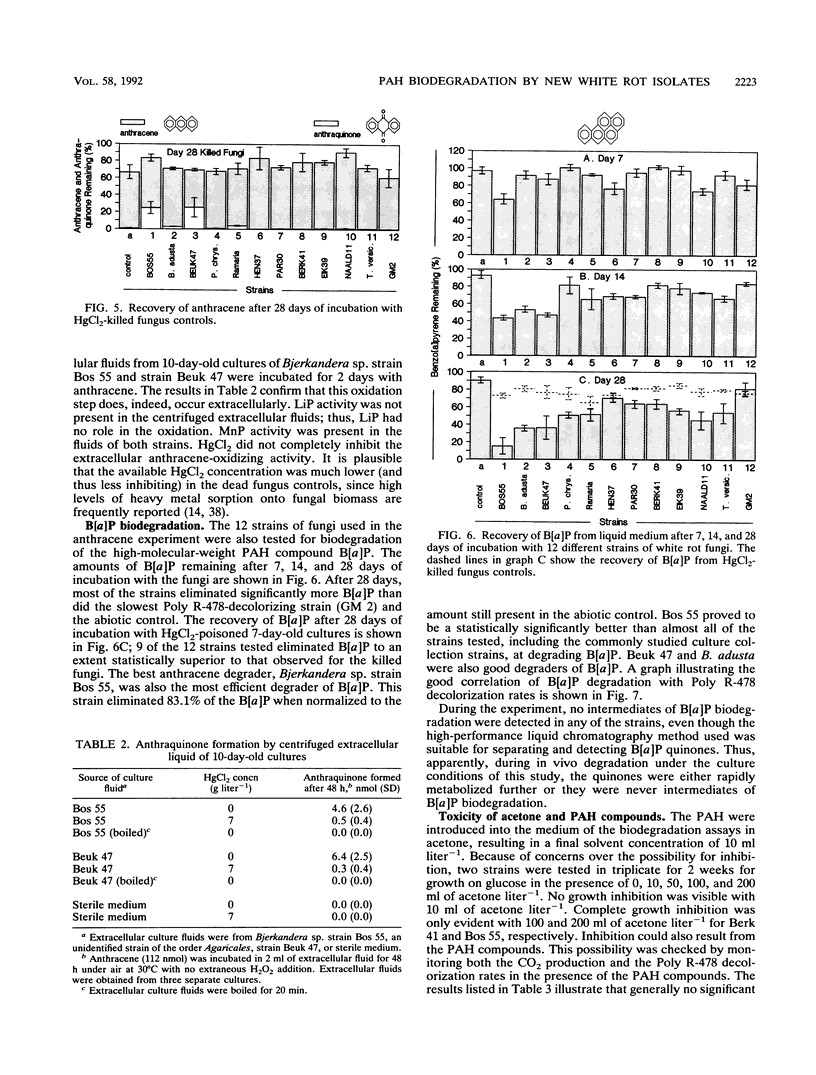
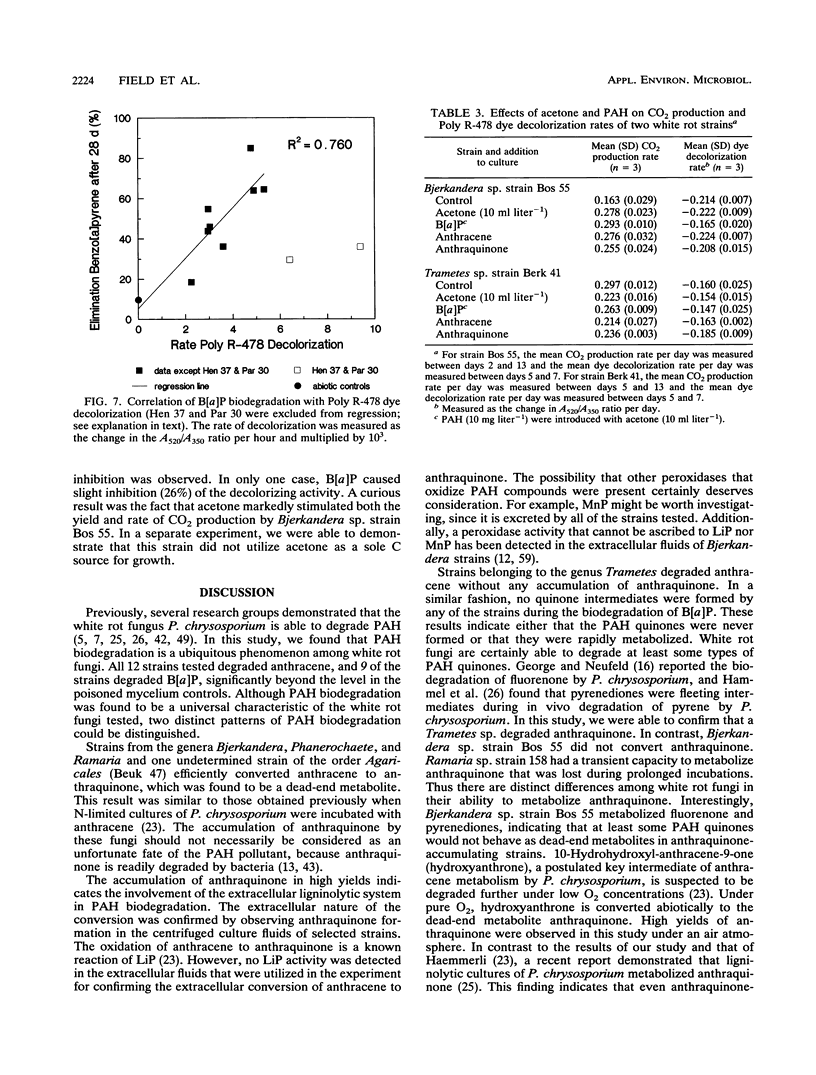
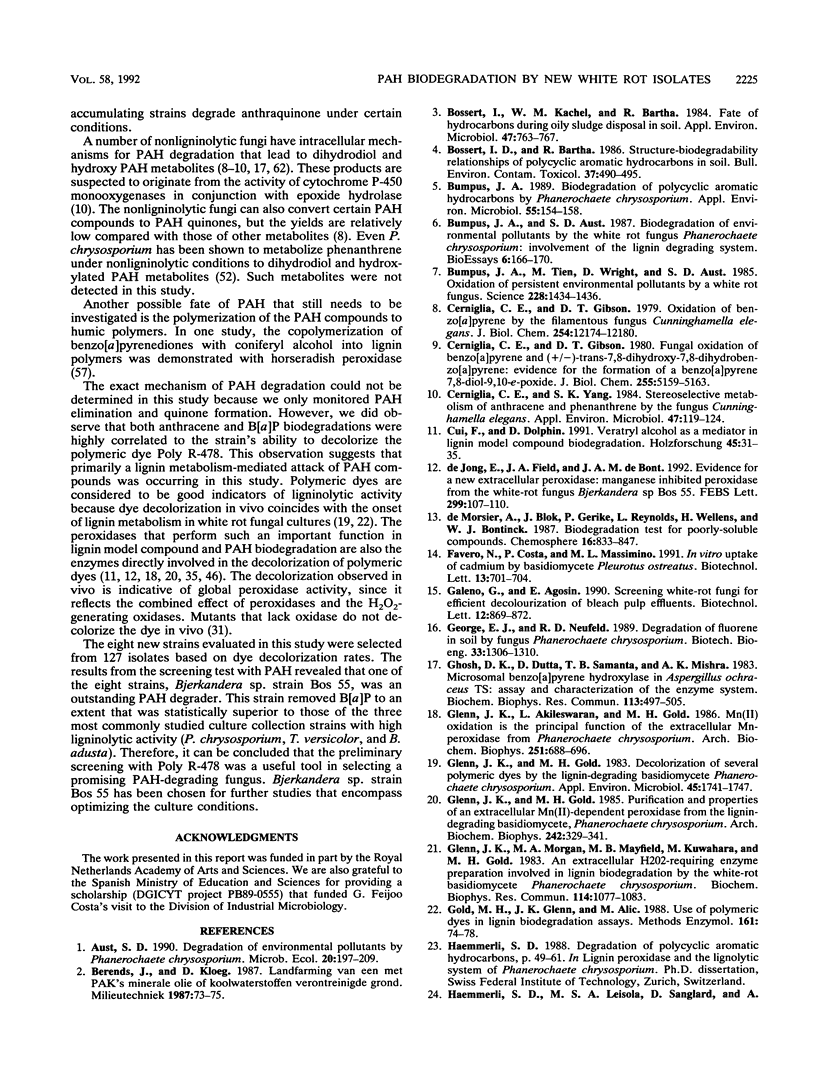
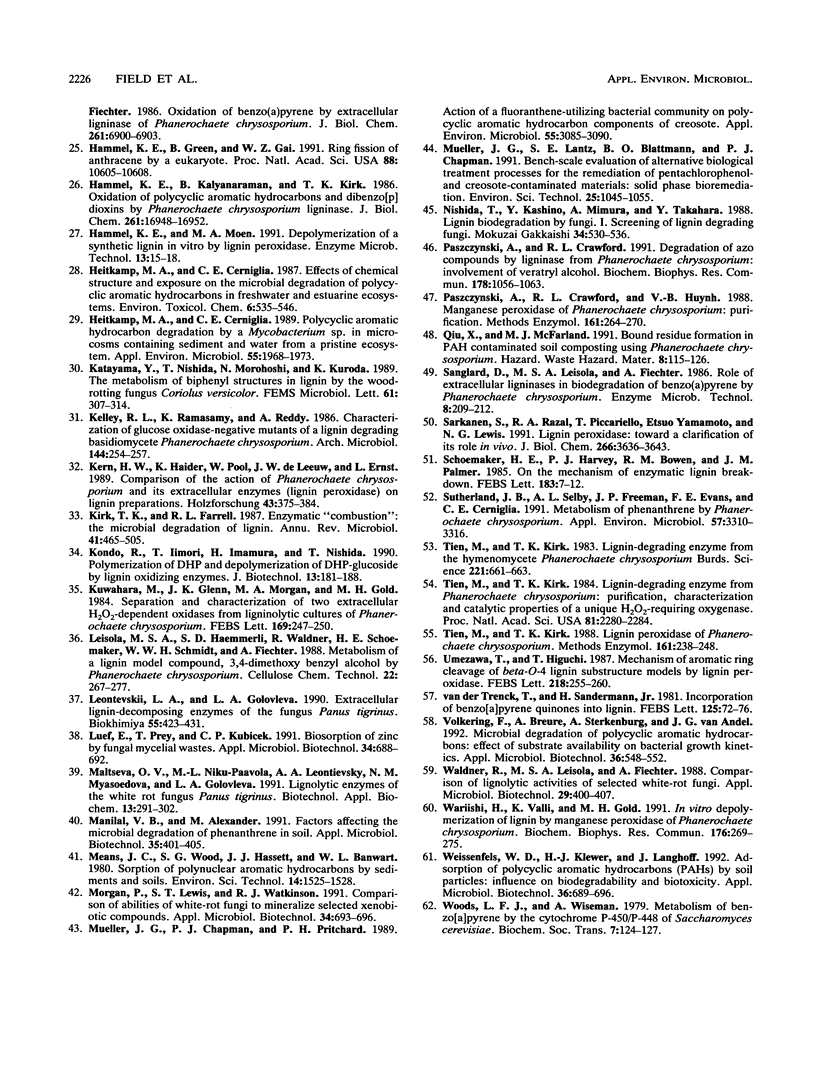
Selected References
These references are in PubMed. This may not be the complete list of references from this article.
- Bossert I. D., Bartha R. Structure-biodegradability relationships of polycyclic aromatic hydrocarbons in soil. Bull Environ Contam Toxicol. 1986 Oct;37(4):490–495. doi: 10.1007/BF01607793. [DOI] [PubMed] [Google Scholar]
- Bossert I., Kachel W. M., Bartha R. Fate of hydrocarbons during oily sludge disposal in soil. Appl Environ Microbiol. 1984 Apr;47(4):763–767. doi: 10.1128/aem.47.4.763-767.1984. [DOI] [PMC free article] [PubMed] [Google Scholar]
- Bumpus J. A. Biodegradation of polycyclic hydrocarbons by Phanerochaete chrysosporium. Appl Environ Microbiol. 1989 Jan;55(1):154–158. doi: 10.1128/aem.55.1.154-158.1989. [DOI] [PMC free article] [PubMed] [Google Scholar]
- Bumpus J. A., Tien M., Wright D., Aust S. D. Oxidation of persistent environmental pollutants by a white rot fungus. Science. 1985 Jun 21;228(4706):1434–1436. doi: 10.1126/science.3925550. [DOI] [PubMed] [Google Scholar]
- Cerniglia C. E., Gibson D. T. Fungal oxidation of benzo[a]pyrene and (+/-)-trans-7,8-dihydroxy-7,8-dihydrobenzo[a]pyrene. Evidence for the formation of a benzo[a]pyrene 7,8-diol-9,10-epoxide. J Biol Chem. 1980 Jun 10;255(11):5159–5163. [PubMed] [Google Scholar]
- Cerniglia C. E., Gibson D. T. Oxidation of benzo[a]pyrene by the filamentous fungus Cunninghamella elegans. J Biol Chem. 1979 Dec 10;254(23):12174–12180. [PubMed] [Google Scholar]
- Cerniglia C. E., Yang S. K. Stereoselective metabolism of anthracene and phenanthrene by the fungus Cunninghamella elegans. Appl Environ Microbiol. 1984 Jan;47(1):119–124. doi: 10.1128/aem.47.1.119-124.1984. [DOI] [PMC free article] [PubMed] [Google Scholar]
- Ernst T., Meinhold G. Ein Beitrag zur angeborenen Aglossie. Dtsch Zahn Mund Kieferheilkd Zentralbl Gesamte. 1964;43(9):375–384. [PubMed] [Google Scholar]
- Ghosh D. K., Dutta D., Samanta T. B., Mishra A. K. Microsomal benzo(a)pyrene hydroxylase in Aspergillus ochraceus TS: assay and characterization of the enzyme system. Biochem Biophys Res Commun. 1983 Jun 15;113(2):497–505. doi: 10.1016/0006-291x(83)91753-9. [DOI] [PubMed] [Google Scholar]
- Glenn J. K., Akileswaran L., Gold M. H. Mn(II) oxidation is the principal function of the extracellular Mn-peroxidase from Phanerochaete chrysosporium. Arch Biochem Biophys. 1986 Dec;251(2):688–696. doi: 10.1016/0003-9861(86)90378-4. [DOI] [PubMed] [Google Scholar]
- Glenn J. K., Gold M. H. Decolorization of Several Polymeric Dyes by the Lignin-Degrading Basidiomycete Phanerochaete chrysosporium. Appl Environ Microbiol. 1983 Jun;45(6):1741–1747. doi: 10.1128/aem.45.6.1741-1747.1983. [DOI] [PMC free article] [PubMed] [Google Scholar]
- Glenn J. K., Gold M. H. Purification and characterization of an extracellular Mn(II)-dependent peroxidase from the lignin-degrading basidiomycete, Phanerochaete chrysosporium. Arch Biochem Biophys. 1985 Nov 1;242(2):329–341. doi: 10.1016/0003-9861(85)90217-6. [DOI] [PubMed] [Google Scholar]
- Glenn J. K., Morgan M. A., Mayfield M. B., Kuwahara M., Gold M. H. An extracellular H2O2-requiring enzyme preparation involved in lignin biodegradation by the white rot basidiomycete Phanerochaete chrysosporium. Biochem Biophys Res Commun. 1983 Aug 12;114(3):1077–1083. doi: 10.1016/0006-291x(83)90672-1. [DOI] [PubMed] [Google Scholar]
- Haemmerli S. D., Leisola M. S., Sanglard D., Fiechter A. Oxidation of benzo(a)pyrene by extracellular ligninases of Phanerochaete chrysosporium. Veratryl alcohol and stability of ligninase. J Biol Chem. 1986 May 25;261(15):6900–6903. [PubMed] [Google Scholar]
- Hammel K. E., Green B., Gai W. Z. Ring fission of anthracene by a eukaryote. Proc Natl Acad Sci U S A. 1991 Dec 1;88(23):10605–10608. doi: 10.1073/pnas.88.23.10605. [DOI] [PMC free article] [PubMed] [Google Scholar]
- Hammel K. E., Kalyanaraman B., Kirk T. K. Oxidation of polycyclic aromatic hydrocarbons and dibenzo[p]-dioxins by Phanerochaete chrysosporium ligninase. J Biol Chem. 1986 Dec 25;261(36):16948–16952. [PubMed] [Google Scholar]
- Heitkamp M. A., Cerniglia C. E. Polycyclic aromatic hydrocarbon degradation by a Mycobacterium sp. in microcosms containing sediment and water from a pristine ecosystem. Appl Environ Microbiol. 1989 Aug;55(8):1968–1973. doi: 10.1128/aem.55.8.1968-1973.1989. [DOI] [PMC free article] [PubMed] [Google Scholar]
- Kirk T. K., Farrell R. L. Enzymatic "combustion": the microbial degradation of lignin. Annu Rev Microbiol. 1987;41:465–505. doi: 10.1146/annurev.mi.41.100187.002341. [DOI] [PubMed] [Google Scholar]
- Mueller J. G., Chapman P. J., Pritchard P. H. Action of a fluoranthene-utilizing bacterial community on polycyclic aromatic hydrocarbon components of creosote. Appl Environ Microbiol. 1989 Dec;55(12):3085–3090. doi: 10.1128/aem.55.12.3085-3090.1989. [DOI] [PMC free article] [PubMed] [Google Scholar]
- Paszczynski A., Crawford R. L. Degradation of azo compounds by ligninase from Phanerochaete chrysosporium: involvement of veratryl alcohol. Biochem Biophys Res Commun. 1991 Aug 15;178(3):1056–1063. doi: 10.1016/0006-291x(91)90999-n. [DOI] [PubMed] [Google Scholar]
- Sarkanen S., Razal R. A., Piccariello T., Yamamoto E., Lewis N. G. Lignin peroxidase: toward a clarification of its role in vivo. J Biol Chem. 1991 Feb 25;266(6):3636–3643. [PubMed] [Google Scholar]
- Sutherland J. B., Selby A. L., Freeman J. P., Evans F. E., Cerniglia C. E. Metabolism of phenanthrene by Phanerochaete chrysosporium. Appl Environ Microbiol. 1991 Nov;57(11):3310–3316. doi: 10.1128/aem.57.11.3310-3316.1991. [DOI] [PMC free article] [PubMed] [Google Scholar]
- Tien M., Kirk T. K. Lignin-Degrading Enzyme from the Hymenomycete Phanerochaete chrysosporium Burds. Science. 1983 Aug 12;221(4611):661–663. doi: 10.1126/science.221.4611.661. [DOI] [PubMed] [Google Scholar]
- Tien M., Kirk T. K. Lignin-degrading enzyme from Phanerochaete chrysosporium: Purification, characterization, and catalytic properties of a unique H(2)O(2)-requiring oxygenase. Proc Natl Acad Sci U S A. 1984 Apr;81(8):2280–2284. doi: 10.1073/pnas.81.8.2280. [DOI] [PMC free article] [PubMed] [Google Scholar]
- Wariishi H., Valli K., Gold M. H. In vitro depolymerization of lignin by manganese peroxidase of Phanerochaete chrysosporium. Biochem Biophys Res Commun. 1991 Apr 15;176(1):269–275. doi: 10.1016/0006-291x(91)90919-x. [DOI] [PubMed] [Google Scholar]
- Weissenfels W. D., Klewer H. J., Langhoff J. Adsorption of polycyclic aromatic hydrocarbons (PAHs) by soil particles: influence on biodegradability and biotoxicity. Appl Microbiol Biotechnol. 1992 Feb;36(5):689–696. doi: 10.1007/BF00183251. [DOI] [PubMed] [Google Scholar]
- Woods L. F., Wiseman A. Metabolism of benzo[a]pyrene by the cytochrome P-450/P-488 of Saccharomyces cerevisiae [proceedings]. Biochem Soc Trans. 1979 Feb;7(1):124–127. doi: 10.1042/bst0070124. [DOI] [PubMed] [Google Scholar]
- de Jong E., Field J. A., de Bont J. A. Evidence for a new extracellular peroxidase. Manganese-inhibited peroxidase from the white-rot fungus Bjerkandera sp. BOS 55. FEBS Lett. 1992 Mar 24;299(1):107–110. doi: 10.1016/0014-5793(92)80111-s. [DOI] [PubMed] [Google Scholar]
- vd Trenck T., Sandermann H., Jr Incorporation of benzo[alpha]pyrene quinones into lignin. FEBS Lett. 1981 Mar 9;125(1):72–76. doi: 10.1016/0014-5793(81)80999-4. [DOI] [PubMed] [Google Scholar]


